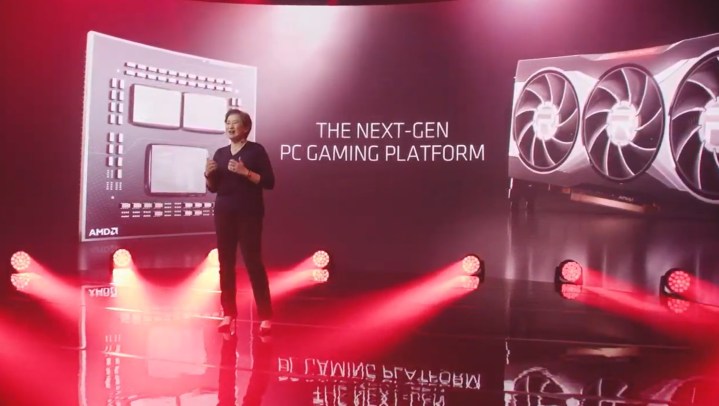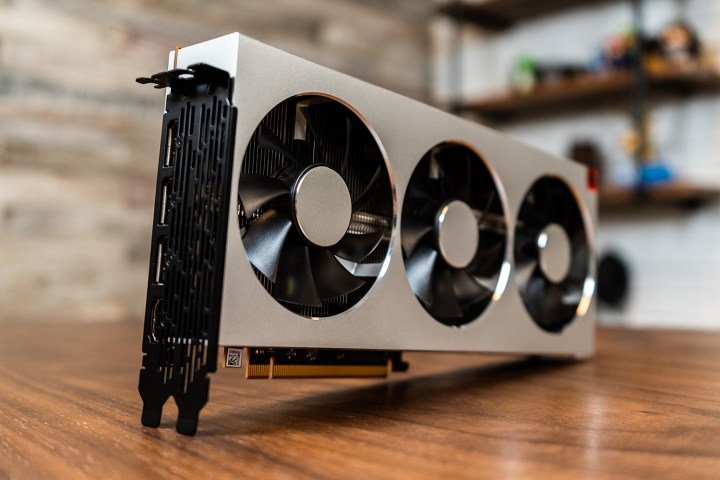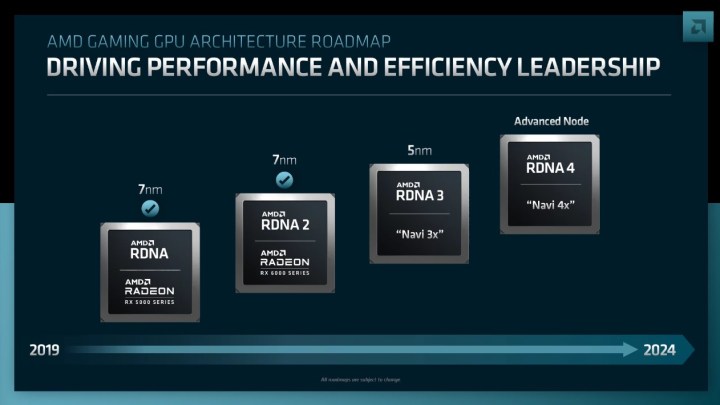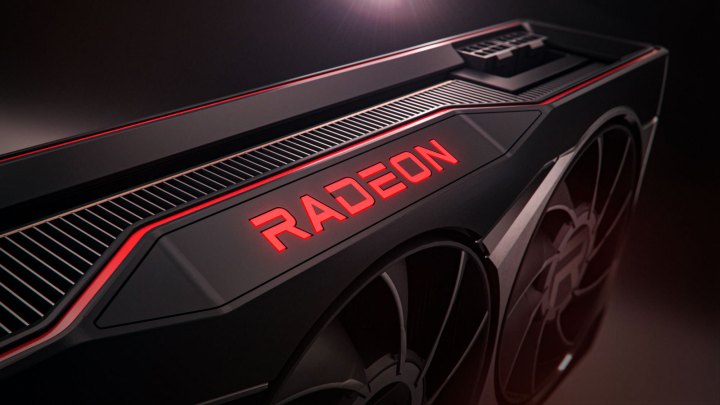AMD Radeon RX 7000 series: Everything we know about the RDNA 3 GPU
Even though gamers looking to upgrade to AMD’s current Radeon RX 6000 series GPUs may feel discouraged due to the global semiconductor shortage, the company is already hard at work on its next-generation graphics cards. The Radeon RX 7000 series, following AMD’s historical naming and numbering convention, is expected to be a powerful upgrade that will make it even more competitive against rival Nvidia’s GeForce cards.
While AMD’s Radeon RX 6000 was based on the company’s 7nm RDNA 2 microarchitecture — a design also found in the Sony PlayStation 5 and Microsoft Xbox Series X — the next-gen Radeon RX 7000 will make the jump to a new RDNA 3 design. As we get closer to launch, more and more details are starting to appear.
Here’s everything we know about AMD’s Radeon RX 7000 graphics cards.
Pricing
Originally expected to arrive sometime in late 2021, AMD has now confirmed that the RDNA 3-based Radeon RX 7000 will make its debut by late 2022. However, there is still no information regarding the pricing. Given that the world has been dealing with a massive semiconductor shortage that has affected the production of both CPUs and GPUs, among other PC components, AMD may be able to launch the new cards at higher prices without causing much concern.
AMD confirmed at its Financial Analyst Day in June that the new Radeon RX 7000 series will offer a 50% improvement in performance per watt over the previous generation. This, in itself, could make the new GPUs pricier alongside high demands due to the recent semiconductor shortages, as well as the U.S. tariffs on imports.
Historically, AMD has priced its cards more competitively against Nvidia, and we expect the situation will likely continue when both companies launch their next-generation lineup of GPUs. That said, gamers should be prepared for an increase in price across the board given supply constraints affecting production, outsized demand for powerful PC components, and tariffs.
Architecture

At the heart of the Radeon RX 7000 series will be AMD’s new RDNA 3 microarchitecture. While RDNA 2 was more colloquially referred to as “Big Navi” by gamers and Navi 2x by AMD executives, RDNA 3 is being referred to as Navi 3x.
Recent rumors suggested that RX 7000 graphics cards could be up to 130% faster than the previous generation overall while staying relatively power efficient. While AMD is still quiet about the details, it has confirmed that the new GPU series will offer more than a 50% improvement in performance per watt over the previous generation. We also have confirmation that AMD will be adopting the 5nm manufacturing process which should help drive some of this performance boost.
AMD has confirmed it will make use of a new chiplet design borrowed from the architecture used on its Ryzen processors for RDNA 3. This change in design could allow the company to double the number of compute units on each die. If all else is the same, we can expect AMD’s GPUs to ship with at least 12GB of VRAM. The company had previously claimed that 12GB of RAM on GPUs is the minimum requirement to be future-proof when playing AAA titles. Current AMD GPUs ship with GDDR6 memory, and we can expect the same with Radeon RX 7000 since Nvidia has an exclusive on the faster GDDR6X standard.
Unlike RDNA 2, which is also found in gaming consoles, RDNA 3 is expected to remain limited to PC gamers. This is because consoles have a shelf life of four to six years, and the actual processing and graphics hardware is typically not upgraded during this time. And even though RDNA 3 won’t be headed to consoles, we do expect to see mobile variants of the Radeon RX 7000 series for laptop gaming. Mobile RX 7000 laptops will likely launch sometime after PC cards have debuted.
Performance


Early reports suggest that gamers can potentially see a performance improvement of two and a half times or 250% over RDNA 2, helping AMD to break its 50% gen-on-gen performance improvement history. So far, though, we haven’t seen any leaked benchmarks to confirm these early theories, but if AMD is able to double the number of compute units and stream processors utilizing the chiplet design ported from its CPUs, we can expect to see some big upticks in graphics performance.
While the RDNA 2 architecture delivered support for ray-tracing for the first time on AMD’s GPUs, making them competitive against rival Nvidia’s RT 2000 and RTX 3000 series graphics cards, we expect AMD will have more to say about improved performance in this area when Radeon RX 7000 series launches.
AMD has additionally confirmed that it has started working on RDNA 4 graphics cards, which could hit markets by late 2023 or early 2024 (the road map is vague on the exact release window). While the company didn’t share specific details about the manufacturing process, it is calling it an “advanced node” in its road map. We can expect RDNA 4 graphics cards to line up with Zen 5, so will use 4nm or 3nm, but AMD hasn’t confirmed any of those details.
Still, not a lot of information is known about RDNA 3 at this time, but at least we now have a confirmation that we will see the first set of models by late 2022.
Editors’ Recommendations
Even though gamers looking to upgrade to AMD’s current Radeon RX 6000 series GPUs may feel discouraged due to the global semiconductor shortage, the company is already hard at work on its next-generation graphics cards. The Radeon RX 7000 series, following AMD’s historical naming and numbering convention, is expected to be a powerful upgrade that will make it even more competitive against rival Nvidia’s GeForce cards.
While AMD’s Radeon RX 6000 was based on the company’s 7nm RDNA 2 microarchitecture — a design also found in the Sony PlayStation 5 and Microsoft Xbox Series X — the next-gen Radeon RX 7000 will make the jump to a new RDNA 3 design. As we get closer to launch, more and more details are starting to appear.
Here’s everything we know about AMD’s Radeon RX 7000 graphics cards.
Pricing

Originally expected to arrive sometime in late 2021, AMD has now confirmed that the RDNA 3-based Radeon RX 7000 will make its debut by late 2022. However, there is still no information regarding the pricing. Given that the world has been dealing with a massive semiconductor shortage that has affected the production of both CPUs and GPUs, among other PC components, AMD may be able to launch the new cards at higher prices without causing much concern.
AMD confirmed at its Financial Analyst Day in June that the new Radeon RX 7000 series will offer a 50% improvement in performance per watt over the previous generation. This, in itself, could make the new GPUs pricier alongside high demands due to the recent semiconductor shortages, as well as the U.S. tariffs on imports.
Historically, AMD has priced its cards more competitively against Nvidia, and we expect the situation will likely continue when both companies launch their next-generation lineup of GPUs. That said, gamers should be prepared for an increase in price across the board given supply constraints affecting production, outsized demand for powerful PC components, and tariffs.
Architecture

At the heart of the Radeon RX 7000 series will be AMD’s new RDNA 3 microarchitecture. While RDNA 2 was more colloquially referred to as “Big Navi” by gamers and Navi 2x by AMD executives, RDNA 3 is being referred to as Navi 3x.
Recent rumors suggested that RX 7000 graphics cards could be up to 130% faster than the previous generation overall while staying relatively power efficient. While AMD is still quiet about the details, it has confirmed that the new GPU series will offer more than a 50% improvement in performance per watt over the previous generation. We also have confirmation that AMD will be adopting the 5nm manufacturing process which should help drive some of this performance boost.
AMD has confirmed it will make use of a new chiplet design borrowed from the architecture used on its Ryzen processors for RDNA 3. This change in design could allow the company to double the number of compute units on each die. If all else is the same, we can expect AMD’s GPUs to ship with at least 12GB of VRAM. The company had previously claimed that 12GB of RAM on GPUs is the minimum requirement to be future-proof when playing AAA titles. Current AMD GPUs ship with GDDR6 memory, and we can expect the same with Radeon RX 7000 since Nvidia has an exclusive on the faster GDDR6X standard.
Unlike RDNA 2, which is also found in gaming consoles, RDNA 3 is expected to remain limited to PC gamers. This is because consoles have a shelf life of four to six years, and the actual processing and graphics hardware is typically not upgraded during this time. And even though RDNA 3 won’t be headed to consoles, we do expect to see mobile variants of the Radeon RX 7000 series for laptop gaming. Mobile RX 7000 laptops will likely launch sometime after PC cards have debuted.
Performance


Early reports suggest that gamers can potentially see a performance improvement of two and a half times or 250% over RDNA 2, helping AMD to break its 50% gen-on-gen performance improvement history. So far, though, we haven’t seen any leaked benchmarks to confirm these early theories, but if AMD is able to double the number of compute units and stream processors utilizing the chiplet design ported from its CPUs, we can expect to see some big upticks in graphics performance.
While the RDNA 2 architecture delivered support for ray-tracing for the first time on AMD’s GPUs, making them competitive against rival Nvidia’s RT 2000 and RTX 3000 series graphics cards, we expect AMD will have more to say about improved performance in this area when Radeon RX 7000 series launches.
AMD has additionally confirmed that it has started working on RDNA 4 graphics cards, which could hit markets by late 2023 or early 2024 (the road map is vague on the exact release window). While the company didn’t share specific details about the manufacturing process, it is calling it an “advanced node” in its road map. We can expect RDNA 4 graphics cards to line up with Zen 5, so will use 4nm or 3nm, but AMD hasn’t confirmed any of those details.
Still, not a lot of information is known about RDNA 3 at this time, but at least we now have a confirmation that we will see the first set of models by late 2022.
Editors’ Recommendations
